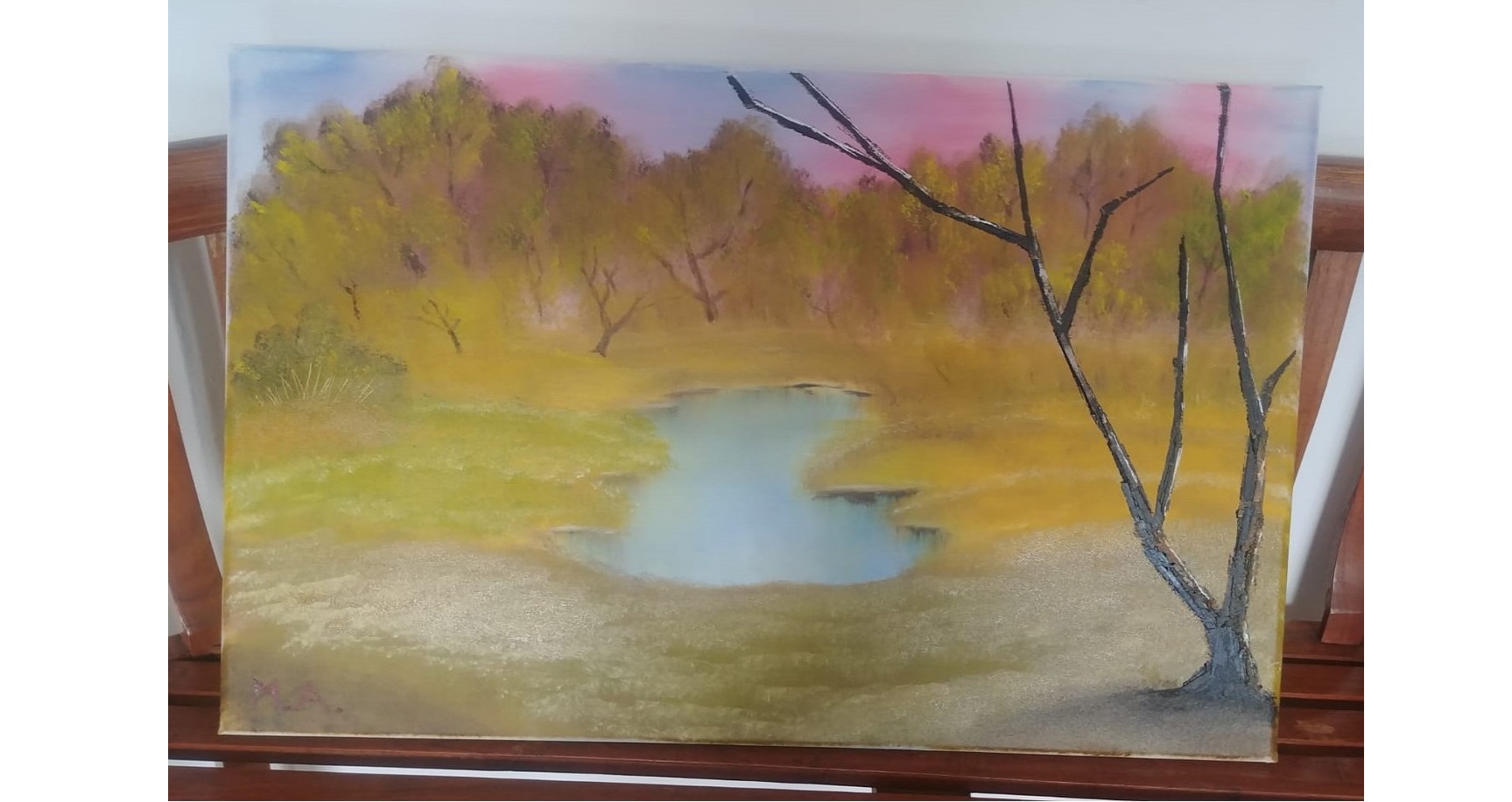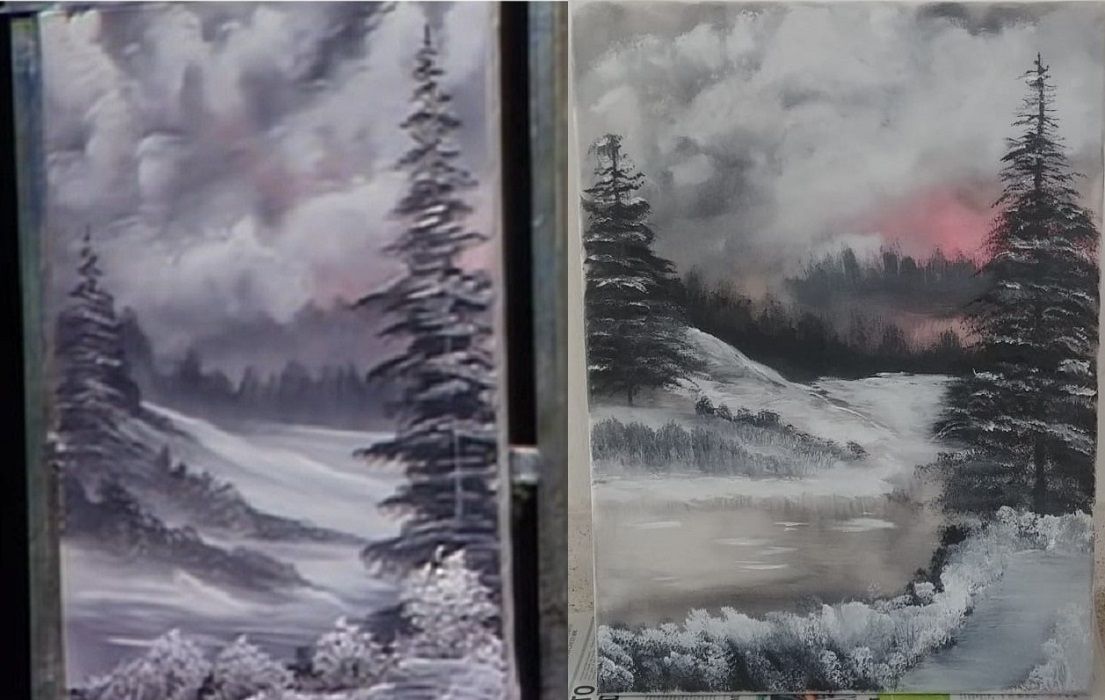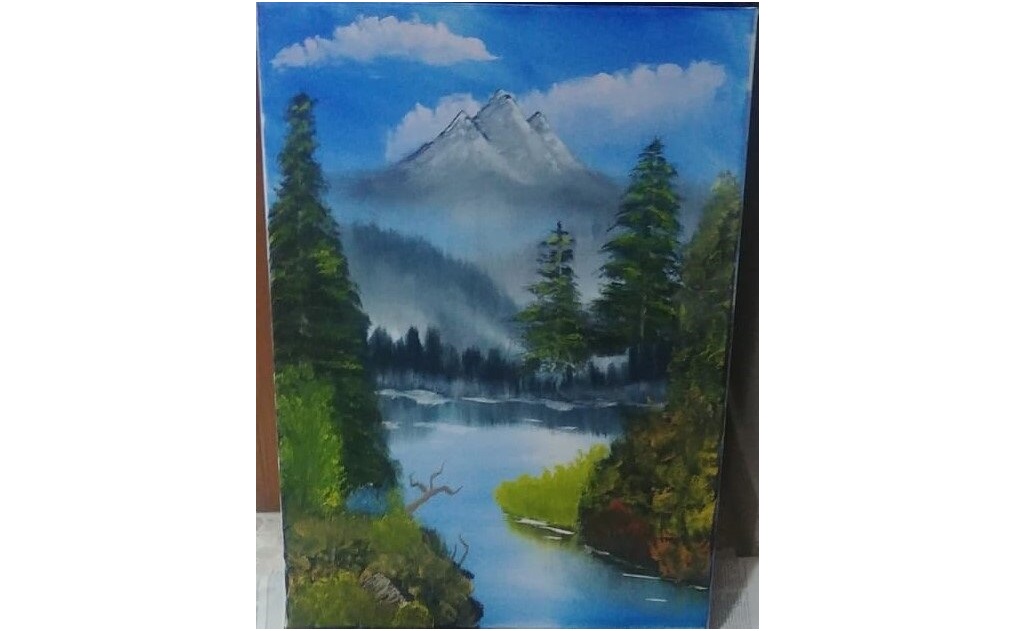Bob Ross for beginners
Here’s how you can go from zero art experience to painting oil landscapes like this.

A Quiet Pond
Man, Myth, Legend
If you don’t know who Bob Ross is, I highly recommend watching some of his YouTube videos.
He was the host of the TV series ‘The Joy of Painting’ from 1983 to 1994 where he would paint a unique oil landscape (much like the one above) each epsiode.
Bob’s relaxed approach to painting and emphasis on having fun attracted many viewers to the show, often just to hear the sound of his soothing voice. I have watched several of his videos myself, and I can personally attest to how addicting they can be. However, the show was always meant to be a painting tutorial, so you could follow along and experience the joys of painting. Bob also made it look very easy, like anyone could do it.
Getting started
So maybe you watched a couple of videos and got decided to try it out yourself - that was me a few months ago. If you don’t have any prior art experience, don’t worry - I didn’t either. It is fairly easy to follow alongside the videos, but there are several important details that Bob doesn’t cover during the show. I’ve compiled a list of pointers to help you get started.
- Watch a few videos end-to-end
Watch a few of Bob’s videos, especially ‘The Grandeur of Summer’, where Bob goes over the equipment he uses and demonstrates the techniques he uses for painting mountains, bushes, trees etc.
Get a feel for his techniques and what the final product will look like.
- Understand the costs
Each painting takes around 2-3 hours if you’re a beginner, depending on how much detail you choose to add.
Purchasing all the equipment from scratch will cost around $100-$200 USD depending on how cheap art supplies are in your country.
- Read up on what others have done
Read this Reddit page.
It is a compilation of Bob Ross tips from other beginner painters.
- Pick a painting
I highly recommend either ‘The Grandeur of Summer’, ‘Grey Winter’,
or ‘Quiet Pond’. They are generally easier for beginners and avoid some of the more difficult techniques.
I have personally painted all 3 myself and can attest to that. But ultimately, it is more important that you pick something you actually want to paint.
- Prepare the equipment
Watch your chosen video again from start to end. Make a list of paints and brushes you will need. You will also need the following equipment.
Equipment Checklist
- Canvas (double or tripled primed, any size is fine but 18"x24" is a good reference)
- Paints (make sure these are thick oil paints)1
- Brushes/Knife (for the 2"/1" brushes, make sure they are good quality and thick, preferrably hog’s hair, never nylon)
- Odorless paint thinner (Turpentine is not recommended, as it damages the brush bristles)
- Pails (for brush cleaning)
- Steam rack (should fit in the pail, for brush beating)2
- Paint pallet (can substitute with large paper plates, just make sure there’s space to pull the paint)
- Old rags (for accident clean-up)
- Refined linseed oil (used to thin paints and to make liquid white)
- Liquid White3
- Easel (can substitute by clipping the canvas to a ladder - make sure it’s secure)
- Laptop/TV (play the video and paint following Bob)
- Prepare the canvas
Bob’s technique is wet-on-wet, which means you’ll cover the canvas with a thin coat of Liquid White before you start painting.
This helps your strong colors blend better and look softer on the canvas.
Be careful not to apply too much paint and aim for a thin even coat.
Your finger should be slightly smeared white when touching the canvas.
Note that Bob does use Liquid Black when painting on black backgrounds, but these paintings are more difficult for beginners.

Grey Winter: Bob on left and me on right. Your paintings won’t always look like Bob’s.
Start painting
Now comes the fun (and stressful!) part. There are different techniques involved in each painting, but here are some general tips.
- Less paint
It might not look like it on video, but Bob uses very little paint in most of his background strokes.
It is very hard to “whiten” a sky that you’ve added too much Phtalo Blue to.
It is much easier to use less blue, blend it and add more if necessary.
- PAUSE
The pause and rewind buttons are your friends. Don’t rush through the painting and rewatch each technique as many times as necessary.
Pause the video and complete each step before moving onto the next.
- Improvise
Your trees, mountains and bushes won’t always look like Bob’s. Sometimes it’s not even a question of technique.
The paints could be of different thickness and the brushes of different quality.
If you’re having trouble producing a sharp edge on your 2" brush, switch to the fan brush. If you accidentally smudged something, try to paint over it. Large blobs of paint can be removed with your knife, but generally smears need to be painted over.
- Brush cleaning
Get the brushes as clean as you can before switching colors. Swirl them in the paint thinner and beat them on your steam rack (ideally in a pail).
Then run them over an old rag a few times to get rid of as much paint thinner as possible.
Having excess thinner on your brush will make your subsequent colors runnier.
- Extra brushes
It might be useful to have a couple of extra brushes on standby.
These can be used while dry to blend colors on canvas(the long horizontal/vertical strokes Bob applies).
You can also use light colors on one brush and dark colors on another, reducing the cleaning and paint required.
- Near vs Far
Bob’s techniques tend to resemble messy smudges when you view them from up close.
They look much better from a few steps back as the landscape blurs.
Try to occasionally stop and look at your painting from afar to give yourself some perspective on what you’re painting.
- Have fun It will take some time to complete your painting, so relax and try to enjoy the process. While you might feel pressured to produce a nice piece of artwork, don’t be afraid to occasionally go off-script to paint the bushes the way you see them.
Completion
Congratulations! You just finished your first art piece. Give it a week or so (maybe two if you live somewhere humid) to dry. Hang it up in your house or store it somewhere safe, but don’t throw it away! You will look back someday and remember the fun you had experiencing the joy of painting. And with that I wish you all the best in your painting journey!

The Grandeur of Summer
-
Don’t feel daunted by the large number of paints or if you can’t find every shade in your local paint store. See how Bob uses the color. If the usage is minimal, you can substitute by mixing colors you already own. ↩︎
-
Not entirely necessary, but ensures you don’t get paint everywhere when brush beating. Can also use a brush beater rack. ↩︎
-
Depending on where you live, you might not be able to find Liquid White in your local art store. You can make it by mixing Linseed oil and Titanium White (paint) in a 1:1 ratio. The final product should have a creamy consistency. ↩︎
